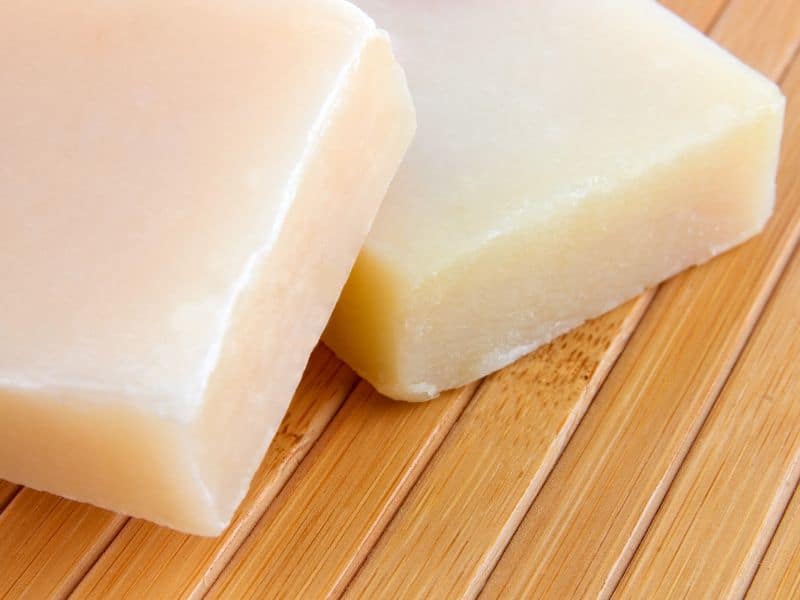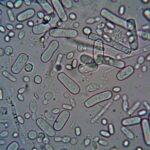When you get into soap making you have a lot of new terminologies to learn. You will discover new words related to the soap-making process and words related to problems that can occur with the soap-making process and even the finished product. That includes learning about DOS.
DOS stands for dreaded orange spots, which are orange patches that appear on the surface or throughout a soap bar due to the oxidation of oils and fats used in the soap recipe. It can affect the appearance, texture, and shelf life of the soap.
The main cause of dreaded orange spots (DOS) is too much air exposure. The oxygen oxidizes the unsaturated oils and fats in the soap, which can lead to an orange color discoloration on the surface or even throughout a bar of soap.
Dreaded Orange Spots (DOS) Explained
As mentioned above, dreaded orange spots is a condition where orange spots or patches develop on the surface or throughout the soap bar. DOS is one of the common problems that soap makers face, and it is important to understand what causes it, how to identify it, and how to prevent it.
Causes of DOS
Ingredients
One of the primary causes of DOS is the use of rancid or low-quality ingredients. When oils or fats are past their prime or have been exposed to air or heat for a long time, they can become oxidized, leading to DOS.
Storage
Improper storage can also lead to DOS. Soap bars should be stored in a cool, dry place away from sunlight and humidity. Exposure to heat and moisture can cause the oils in the soap to go rancid, leading to DOS.
Temperature
High temperatures during the soap making process or during storage can cause DOS. When soap is heated above a certain temperature, it can cause the oils to break down and become rancid.
Effects of DOS
Appearance
DOS can cause orange spots or patches to develop on the surface or throughout the soap bar. This can make the soap look unattractive and unsellable.
Texture
DOS can also affect the texture of the soap. The spots can cause the soap to become soft, greasy, or slimy.
Shelf life
The presence of DOS can shorten the shelf life of the soap. When oils become rancid, they can cause the soap to spoil faster.
Performance
DOS can also affect the performance of the soap. The spots can cause the soap to lather poorly, leave a greasy residue, or even irritate the skin.
It is important to identify and address DOS early on to prevent it from affecting the quality and performance of the soap.
How to Identify DOS
Identifying DOS is critical in preventing it from affecting the quality and performance of the soap. Here are some ways to identify DOS:
Physical Characteristics
The presence of orange spots or patches on the soap bar is a tell-tale sign of DOS. The spots can range in size and can be present on the surface or throughout the bar.
Smell
DOS can also cause the soap to have an unpleasant odor, similar to rancid oil or fat.
Testing Methods
Some testing methods can be used to confirm the presence of DOS. For example, the oil from the soap can be extracted and tested for peroxide value, which is an indicator of oxidation.
How to Prevent DOS
Preventing DOS is critical in creating high-quality and long-lasting soap bars. Here are some ways to prevent DOS:
Choosing Quality Ingredients
Using high-quality and fresh oils and fats can prevent the occurrence of DOS. Be sure to check the expiration date of the ingredients before using them.
Proper Storage
Storing soap bars in a cool, dry place away from sunlight and humidity can prevent the oils from going rancid.
Avoiding Extreme Temperatures
Avoid exposing the soap to high temperatures during the soap making process or during storage.
Using Antioxidants
Antioxidants can help prevent the oxidation of the oils and fats in the soap. Adding vitamin E or rosemary oleoresin extract (ROE) to the soap recipe can act as an antioxidant.
Understanding how to identify and prevent DOS is crucial in creating high-quality and long-lasting soap bars.
How to Remove DOS
If you discover DOS on your soap bar, there are a few methods that you can use to remove it:
Cutting off Affected Portions
If the DOS is localized to a particular area of the soap bar, cutting off the affected portion can help salvage the rest of the soap bar.
B. Rebatching: Rebatching is another method of removing DOS. This involves grating the soap bar, melting it down, and adding additional oils and fats. The rebatched soap can then be molded into a new soap bar.
Neutralizing with Citric Acid
Neutralizing the soap with citric acid can help remove the orange spots caused by DOS. This involves dissolving citric acid in water and adding it to the soap batter before pouring it into the mold.
It’s important to note that removing DOS is not a guaranteed process, and there is a risk of damaging the soap bar or altering its texture and performance.
Tips for Avoiding Dreaded Orange Spots
- Use fresh and high-quality oils and fats in soap recipe
- Store ingredients properly in a cool and dry place away from sunlight
- Avoid exposure to extreme temperatures during soap making process
- Use antioxidants such as vitamin E or rosemary oleoresin extract (ROE) in the soap recipe
- Monitor the pH levels of the soap during the curing process
- Keep the soap bars in a dry and well-ventilated area while curing
- Avoid using water that has a high mineral content or chlorine when making soap
Frequently Asked Questions
DOS is identified by the presence of orange spots or patches on the surface or throughout the soap bar.
Rancid or stale oils and fats can cause DOS, such as those that have gone past their expiration date.
DOS can appear on a soap bar within a few weeks to a few months after it has been made.
No, citric acid does not have a strong odor and will not affect the scent of the soap.
No, DOS is not a health hazard and does not pose any risks to human health. However, it can affect the quality and performance of the soap.
Conclusion
In conclusion, dreaded orange spots (DOS) are a common issue that soap makers may face. It is caused by the oxidation of oils and fats used in the soap recipe and can affect the performance, shelf life, and appearance of the soap bar.
There are several methods to remove DOS such as cutting off affected portions, rebatching, or neutralizing with citric acid. However, it is important to note that removing DOS is not a guaranteed process and there is a risk of damaging the soap bar or altering its texture and performance.






